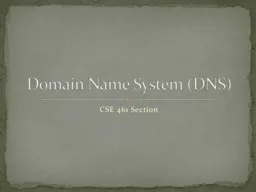

Port numbers for applications MAC addresses for hardware IP addresses for a way to send data in a smart routable way Addressing So Far Problems with MACsIPsPorts Humans are bad at remembering strings of numbers ID: 719996
Download Presentation The PPT/PDF document "CSE 461 Section Domain Name System (DNS..." is the property of its rightful owner. Permission is granted to download and print the materials on this web site for personal, non-commercial use only, and to display it on your personal computer provided you do not modify the materials and that you retain all copyright notices contained in the materials. By downloading content from our website, you accept the terms of this agreement.
Slide1
CSE 461 Section
Domain Name System (DNS)Slide2
Port numbers for applications
MAC addresses for
hardwareIP addresses for a way to send data in a smart, routable way
Addressing So FarSlide3
Problems with MACs/IPs/Ports
Humans
are bad at
remembering strings of numbersWe need a human-friendly naming system!Slide4
What do we need?As short as possible
Easy to memorize
(i.e., not arbitrary)UniqueCustomizable
HierarchicalReflect organizational structure
A way to quickly translate to and from the existing, computer-friendly addressing systems
Ideally, we’d like to address specific resources as well
Requirements for Human-Readable Naming SystemSlide5
Human-readable “domain names” map to IP addresses (names < 254 characters)A human can type
www.google.com
into their browser, and the browser will (somehow) know to go to 173.194.33.179But how might this be done?
Some sort of hash(not really practical)A file of all of the mappings
Separate servers to provide
the mappings
Domain NamesSlide6
Systems keep a small cache of mappings they knowWhen a domain name is used that isn’t in the cache, the system queries a name server
Simple
UDP communication on port 53Database is distributed
Hierarchical namespace: it’sname servers all the way down
Hierarchical DNS ServersSlide7
Series of Question/Response messages
DNS
ProtocolSlide8
Questions contain 3 fields:Name:
What resource we are querying for:
0x6google0x3com0x0
Type:Can specify what we are trying to resolve for: mail, IPv4, ns
…
Class:
Usually set to internet class, capable of being others
DNS
Protocol – Question Entries
Question
Name
Question
Type
Question ClassSlide9
Resource Record:Name/Type/Class same as before
Time-To-Live:
Lease time this record will be valid to cache forData:
Whatever the Type specifies for the data
DNS
Protocol – Answer Resource Records
Name
Type
Class
TTL
Data Length
DataSlide10
Domain HierarchySlide11
If I type
sports.huskies.com
, what happens?Check /etc
/hostsCheck DNS cache
Check local DNS server
Go down hierarchy and ask:
Ask . DNS root server
Ask .com TLD (Top
Level
Domain) serverAsk
huskies.com’s
NS
Send HTTP request to the
IP address
obtained
Resolving a Domain NameSlide12
“A local DNS server does not strictly belong to the hierarchy of servers but is nevertheless central to the DNS architecture. Each ISP—such as a university, an academic department, an employee’s company, or a residential ISP—has a local DNS server (also called a default name server).
”
Local DNS ServerSlide13
DNS servers can return different IP address results for the same domain nameWhy is this useful?
Also
, multiple domain names can map to one IP addressWhy is this useful?
Multiple IP Addresses and AliasingSlide14
Attacks and Other Fun
What are some ways this system can break?
DoS attacks on DNS server
Done before, in 2002 and 2007Not much impact due to filtering and caching
Return incorrect IP address to a DNS request
Could even return the IP of our own server!
Commonly done by ISPs
Compromise root
serversSlide15
DNS Usages – Load Balancing
Take advantage of multiple IP aliasing to round robin deliver services different IP addresses
Linux queries IP of first record returned from
DNSIP address returned does not guarantee that host is available